Grouping in Windows Forms DataGrid (SfDataGrid)
21 Jan 202522 minutes to read
SfDataGrid allows to group the data against one or more columns. When grouping is applied, the data is organized into a hierarchical structure based on matching column values and it is sorted by ascending order.
UI Grouping
End-user can group the data by setting SfDataGrid.AllowGrouping property to true, where user can drag and drop the column into GroupDropArea to group based on that column.
When the column is grouped, records that have an identical value in the column are combined to form a group. The GroupDropArea can be enabled by setting the SfDataGrid.ShowGroupDropArea property to true.
this.sfDataGrid1.AllowGrouping = true;Me.sfDataGrid1.AllowGrouping = TrueGrouping for particular column can be enables or disabled by setting the GridColumnBase.AllowGrouping property.
this.sfDataGrid1.Columns["OrderID"].AllowGrouping = true;
this.sfDataGrid1.Columns["CustomerID"].AllowGrouping = true;Me.sfDataGrid1.Columns("OrderID").AllowGrouping = True
Me.sfDataGrid1.Columns("CustomerID").AllowGrouping = TrueNOTE
GridColumn.AllowGrouping takes higher priority than SfDataGrid.AllowGrouping.
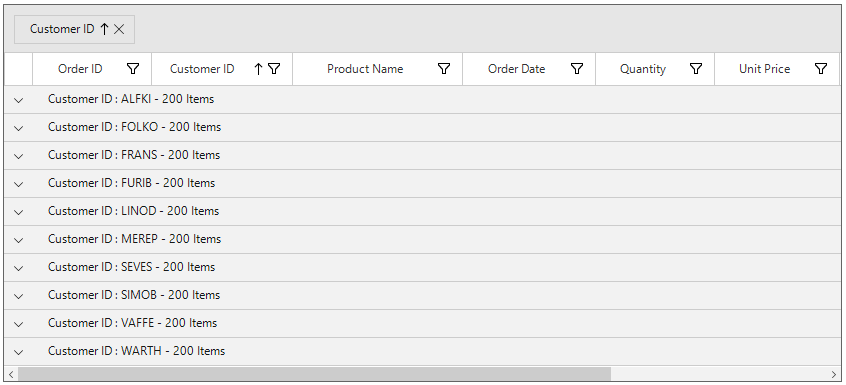
The data can be grouped by an unlimited number of columns. To group more than one columns, drag-and-drop the desired columns in to GroupDropArea.
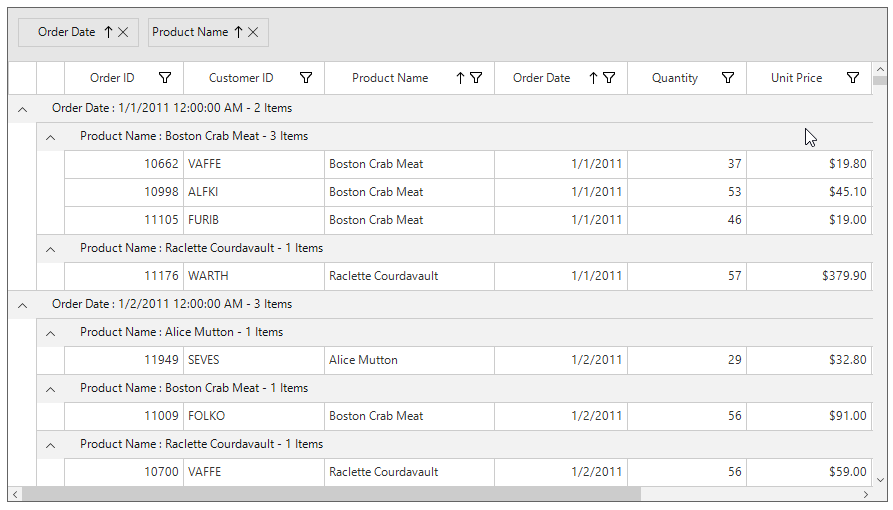
Each group is identified by its CaptionSummaryRows and it is used to organize the data into a hierarchical tree structure based on identical values of that column. The underlying records in each caption summary row can be expanded or collapsed by clicking its group caption.
Each CaptionSummaryRow carries information about a particular group like group name, number of items (records) in the group, etc. Refer the Caption Summaries section, for more information about CaptionSummaryRow.
Programmatic Grouping
Adding Groups
SfDataGrid allows to group the data programmatically by adding or removing [GroupColumnDescription](https://help.syncfusion.com/cr/windowsforms/Syncfusion.WinForms.DataGrid.GroupColumnDescription.html# “”) to SfDataGrid.GroupColumnDescriptions collection.
If OrderID column need to be grouped programmatically, define its MappingName to ColumnName property of GroupColumnDescription. Then add the GroupColumnDescription to the SfDataGrid.GroupColumnDescriptions collection.
this.sfDataGrid1.GroupColumnDescriptions.Add(new GroupColumnDescription() { ColumnName = "OrderID" });Me.sfDataGrid1.GroupColumnDescriptions.Add(New GroupColumnDescription() With {.ColumnName = "OrderID"})Removing Groups
The groups can be removed by removing [GroupColumnDescription](https://help.syncfusion.com/cr/windowsforms/Syncfusion.WinForms.DataGrid.GroupColumnDescription.html# “”) from SfDataGrid.GroupColumnDescriptions collection or by specifying the index using the RemoveAt method.
this.sfDataGrid1.GroupColumnDescriptions.Remove(new GroupColumnDescription() { ColumnName = "OrderID" });
// OR
this.sfDataGrid1.GroupColumnDescriptions.RemoveAt(1);Me.sfDataGrid1.GroupColumnDescriptions.Remove(New GroupColumnDescription() With {.ColumnName = "OrderID"})
' OR
Me.sfDataGrid1.GroupColumnDescriptions.RemoveAt(1)To ungroup the column in UI, click the close button on column header or drag the column header from the GroupDropArea and drop it on the header row.
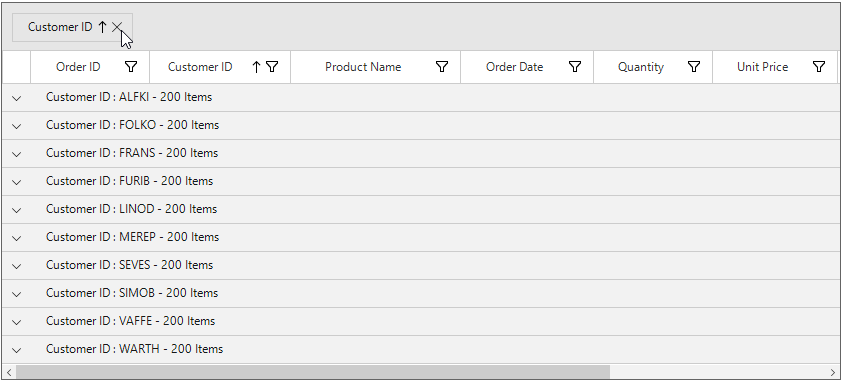
Clearing Groups
All the groups of the SfDataGrid can be removed by using Clear method.
this.sfDataGrid1.GroupColumnDescriptions.Clear();Me.sfDataGrid1.GroupColumnDescriptions.Clear()Formatting Built-in Group Caption
The group caption text can be formatted using the SfDataGrid.GroupCaptionTextFormat property.
The default group caption format is {ColumnName}: {Key} - {ItemsCount} Items.
- ColumnName - Displays the name of the column currently grouped.
- Key - Displays the key value of group.
- ItemsCount - Displays the number of items in group.
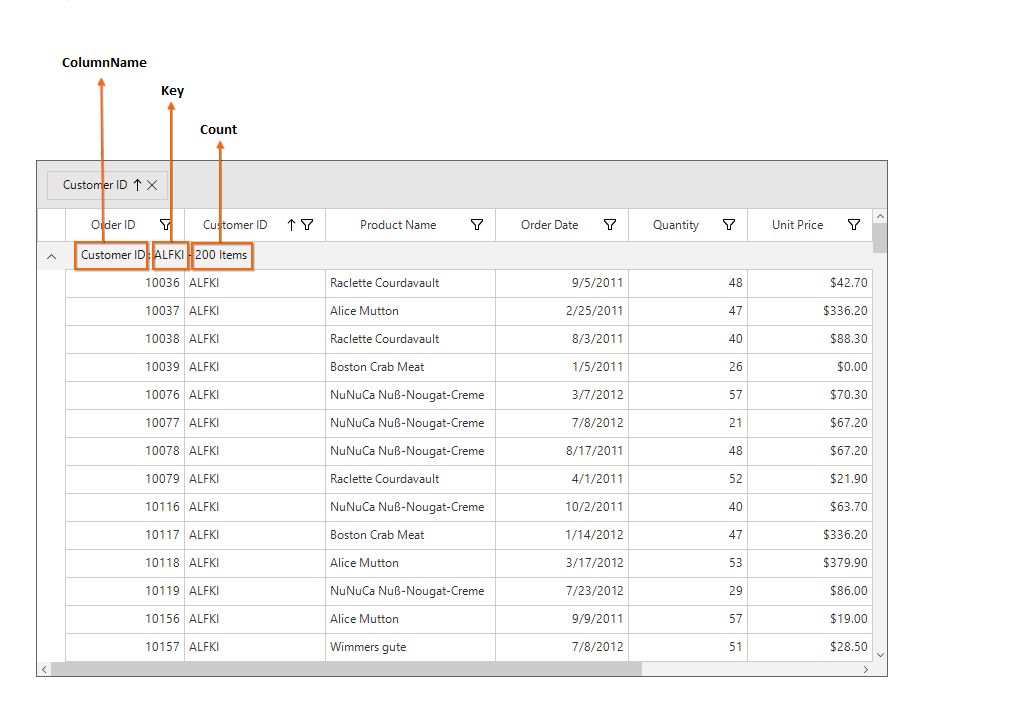
The group caption format can be changed to Key and ItemsCount alone by setting GroupCaptionTextFormat as below,
this.sfDataGrid1.GroupCaptionTextFormat = "{Key} : {ItemsCount}";Me.sfDataGrid1.GroupCaptionTextFormat = "{Key} : {ItemsCount}"
Expanding or Collapsing the Groups
By default, the records in each group can be viewed by expanding its group caption.
The end-user can expand or collapse the groups programmatically at runtime.
Expand Groups while Grouping
All the groups can be expanded while grouping by setting SfDataGrid.View.AutoExpandGroups to true. So, when user group any column, all groups will be in expanded state.
this.sfDataGrid1.View.AutoExpandGroups = true;Me.sfDataGrid1.View.AutoExpandGroups = TrueProgrammatically Expanding or Collapsing the Groups
Expand or Collapse All the Groups
All the groups can be expanded or collapsed programmatically at runtime by using SfDataGrid.ExpandAllGroup and SfDataGrid.CollapseAllGroup methods.
this.sfDataGrid1.ExpandAllGroup();
this.sfDataGrid1.CollapseAllGroup();Me.sfDataGrid1.ExpandAllGroup()
Me.sfDataGrid1.CollapseAllGroup()Expand or Collapse the Group based on its Level
Groups can be expanded or collapsed based on its level by using SfDataGrid.ExpandGroupsAtLevel and SfDataGrid.CollapseGroupsAtLevel methods.
this.sfDataGrid1.ExpandGroupsAtLevel(2);
this.sfDataGrid1.CollapseGroupsAtLevel(2);Me.sfDataGrid1.ExpandGroupsAtLevel(2)
Me.sfDataGrid1.CollapseGroupsAtLevel(2)Expand or Collapse the Specific Group
Specific group can be expanded or collapsed by using SfDataGrid.ExpandGroup and SfDataGrid.CollapseGroup methods.
this.sfDataGrid1.ExpandGroup(this.sfDataGrid1.View.TopLevelGroup);
this.sfDataGrid1.CollapseGroup(this.sfDataGrid1.View.TopLevelGroup);Me.sfDataGrid1.ExpandGroup(Me.sfDataGrid1.View.TopLevelGroup)
Me.sfDataGrid1.CollapseGroup(Me.sfDataGrid1.View.TopLevelGroup)Changing the Indent Column Width
The width of IndentColumn in SfDataGrid can be customized by using IndentColumnWidth property as like below.
this.sfDataGrid1.IndentColumnWidth = 100;Me.sfDataGrid1.IndentColumnWidth = 100
GroupDropArea Customization
Auto fit group drop area items
You can enable datagrid to auto fit content for grouped items in GroupDropArea by using the sfDataGrid.AutoFitGroupDropAreaItem property.
this.sfDataGrid.AutoFitGroupDropAreaItem = true;Me.sfDataGrid.AutoFitGroupDropAreaItem = True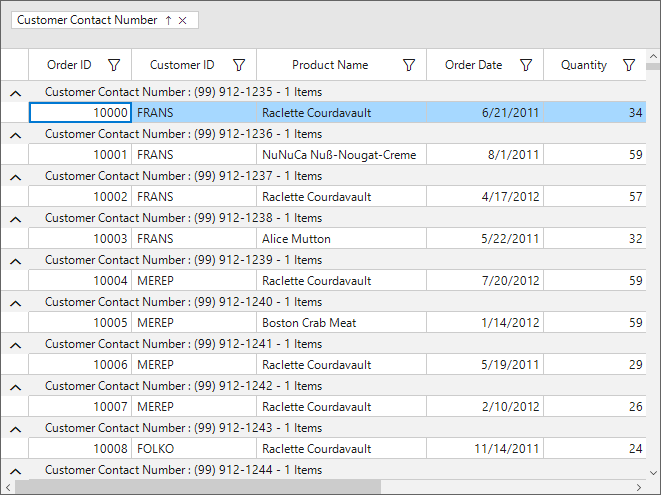
Customizing group drop area items position
The group drop area items position can be adjusted using the sfDataGrid.GroupPanel.Margin property.
this.sfDataGrid.GroupPanel.Margin = new Padding(12);Me.sfDataGrid.GroupPanel.Margin = New Padding(12)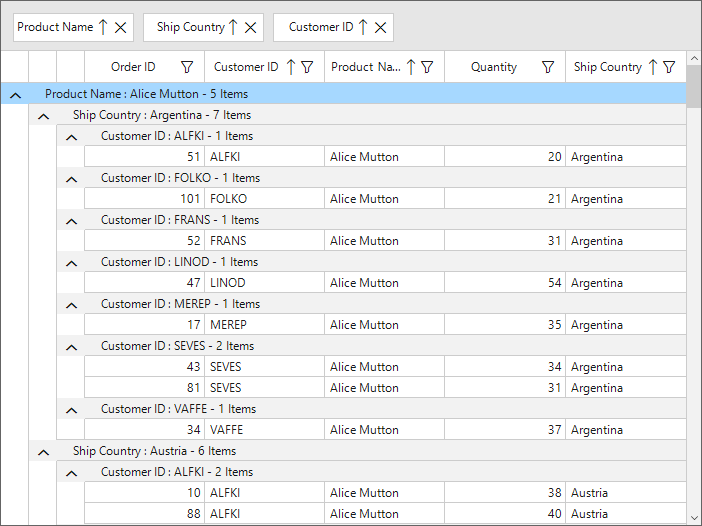
Customizing GroupDropArea Text
The GroupDropArea’ s text can be changed by setting SfDataGrid.GroupPanel.GroupDropAreaText property.
this.sfDataGrid1.GroupPanel.GroupDropAreaText = "Drag columns here";Me.sfDataGrid1.GroupPanel.GroupDropAreaText = "Drag columns here"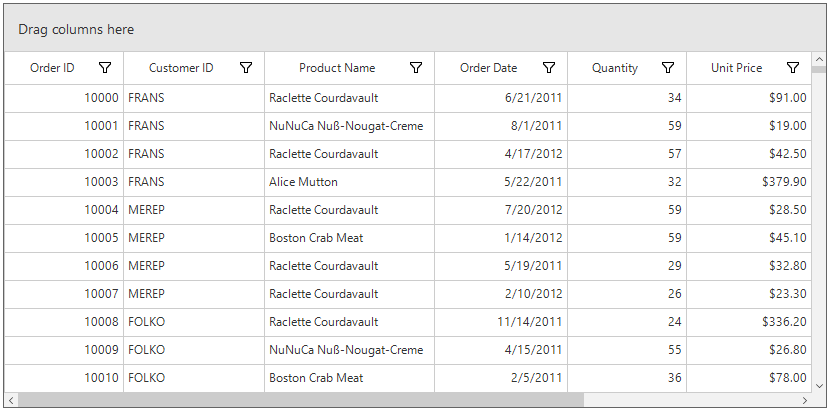
Customizing GroupDropArea Height
SfDataGrid allows to customize the appearance and height of GroupDropArea.
The height of the GroupDropArea can be customized by GroupPanel.Height property.
this.sfDataGrid1.GroupPanel.Height = 100;Me.sfDataGrid1.GroupPanel.Height = 100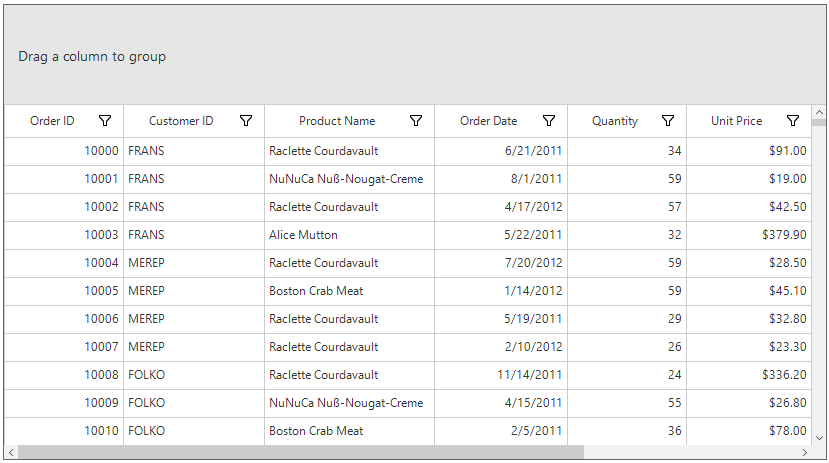
Customizing GroupDropArea Appearance
The appearance of the GroupDropArea can be customized using the GroupDropAreaStyle property. The[GroupDropAreaStyleInfo](https://help.syncfusion.com/cr/windowsforms/Syncfusion.WinForms.DataGrid.Styles.GroupDropAreaStyleInfo.html# “”) contains all the settings that are needed for the GroupDropArea appearance customization.
this.sfDataGrid1.Style.GroupDropAreaStyle.BackColor = Color.LightSkyBlue;
this.sfDataGrid1.Style.GroupDropAreaStyle.TextColor = Color.Red;Me.sfDataGrid1.Style.GroupDropAreaStyle.BackColor = Color.LightSkyBlue
Me.sfDataGrid1.Style.GroupDropAreaStyle.TextColor = Color.Red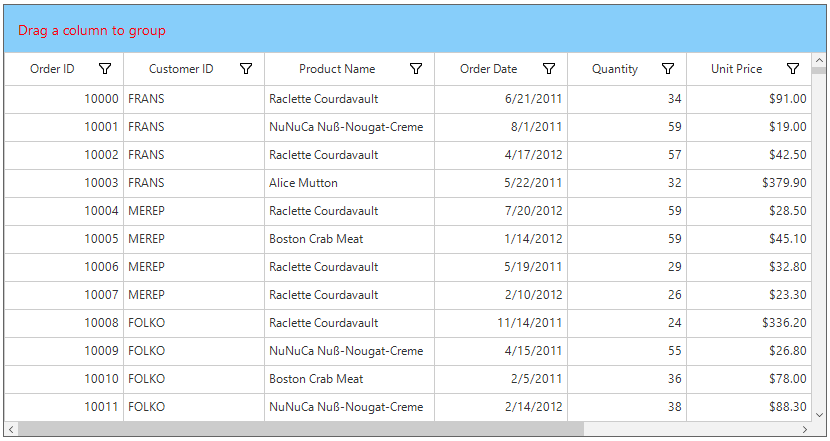
Customizing GroupDropAreaItem Appearance
The appearance of the grouped items in the GroupDropArea can be customized using the GroupDropAreaItemStyle property. The[GroupDropAreaItemStyleInfo](https://help.syncfusion.com/cr/windowsforms/Syncfusion.WinForms.DataGrid.Styles.GroupDropAreaItemStyleInfo.html# “”) contains all the settings that are needed for the grouped items appearance customization.
this.sfDataGrid1.Style.GroupDropAreaItemStyle.TextColor = Color.DarkBlue;
this.sfDataGrid1.Style.GroupDropAreaItemStyle.BackColor = Color.LightSkyBlue;Me.sfDataGrid1.Style.GroupDropAreaItemStyle.TextColor = Color.DarkBlue
Me.sfDataGrid1.Style.GroupDropAreaItemStyle.BackColor = Color.LightSkyBlue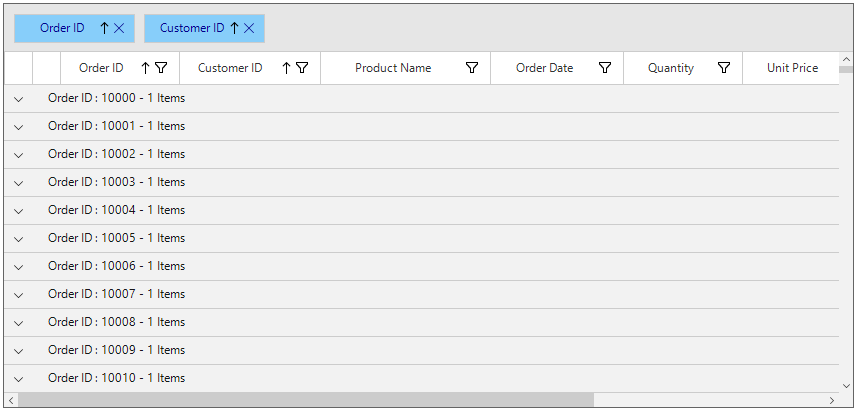
Custom Grouping
SfDataGrid allows to group the data based on custom logic when the built-in grouping functionality doesn’t meet your requirement.
To perform custom grouping on a particular column, specify the custom logic through GroupColumnDescription.KeySelector property and the column name to GroupColumnDescription.ColumnName property.
For an example, the Date column is grouped based on the week basis in the following example.
//Apply the CustomGrouping for Date Column by using KeySelector.
this.sfDataGrid.GroupColumnDescriptions.Add(new GroupColumnDescription()
{
ColumnName = "Date",
KeySelector = (string ColumnName, object o) =>
{
var dt = DateTime.Now;
var item = (o as SalesByDate).Date;
var days = (int)Math.Floor((dt - item).TotalDays);
var dayOfWeek = (int)dt.DayOfWeek;
var difference = days - dayOfWeek;
if (days <= dayOfWeek)
{
if (days == 0)
return "TODAY";
if (days == 1)
return "YESTERDAY";
return item.Date.DayOfWeek.ToString().ToUpper();
}
if (difference > 0 && difference <= 7)
return "LAST WEEK";
if (difference > 7 && difference <= 14)
return "TWO WEEKS AGO";
if (difference > 14 && difference <= 21)
return "THREE WEEKS AGO";
if (dt.Year == item.Date.Year && dt.Month == item.Date.Month)
return "EARLIER THIS MONTH";
if (DateTime.Now.AddMonths(-1).Month == item.Date.Month)
return "LAST MONTH";
return "OLDER";
}
});Private Sub New()
Dim dt = DateTime.Now
Dim item = (TryCast(o, SalesByDate)).Date
Dim days = CInt(Fix(Math.Floor((dt - item).TotalDays)))
Dim dayOfWeek = CInt(Fix(dt.DayOfWeek))
Dim difference = days - dayOfWeek
If days <= dayOfWeek Then
If days = 0 Then
Return "TODAY"
End If
If days = 1 Then
Return "YESTERDAY"
End If
Return item.Date.DayOfWeek.ToString().ToUpper()
End If
If difference > 0 AndAlso difference <= 7 Then
Return "LAST WEEK"
End If
If difference > 7 AndAlso difference <= 14 Then
Return "TWO WEEKS AGO"
End If
If difference > 14 AndAlso difference <= 21 Then
Return "THREE WEEKS AGO"
End If
If dt.Year = item.Date.Year AndAlso dt.Month = item.Date.Month Then
Return "EARLIER THIS MONTH"
End If
If DateTime.Now.AddMonths(-1).Month = item.Date.Month Then
Return "LAST MONTH"
End If
Return "OLDER"
End Sub
End Function
Private )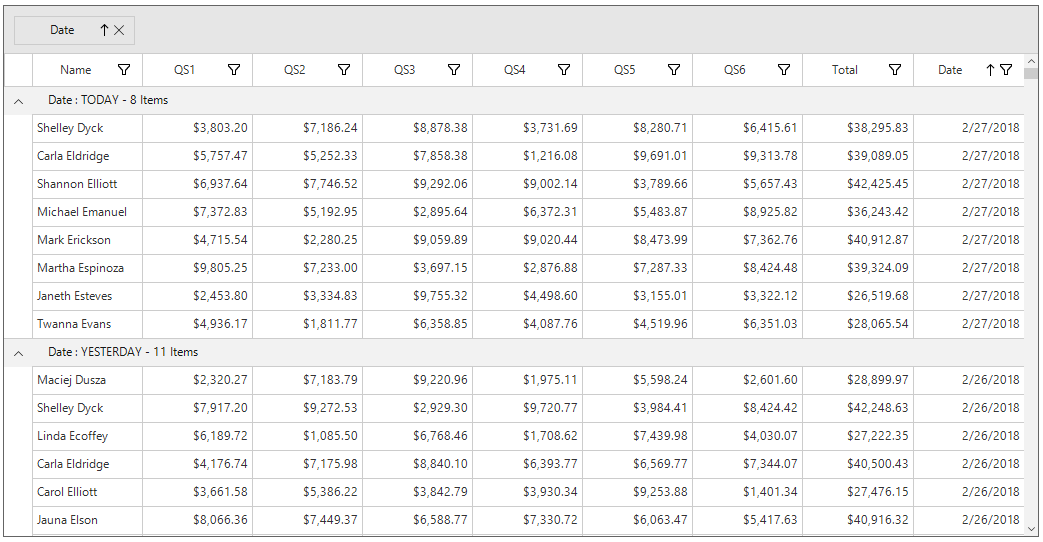
Sorting Inner Records
In custom grouping, all the inner records of each group can be sort by setting GroupColumnDescription.SortGroupRecords sorted based on the column name described in GroupColumnDescription.
this.sfDataGrid.GroupColumnDescriptions.Add(new GroupColumnDescription()
{
ColumnName = "Date",
SortGroupRecords = true,
KeySelector = (string ColumnName, object o) =>
{
var dt = DateTime.Now;
var item = (o as SalesByDate).Date;
var days = (int)Math.Floor((dt - item).TotalDays);
var dayOfWeek = (int)dt.DayOfWeek;
var difference = days - dayOfWeek;
if (days <= dayOfWeek)
{
if (days == 0)
return "TODAY";
if (days == 1)
return "YESTERDAY";
return item.Date.DayOfWeek.ToString().ToUpper();
}
if (difference > 0 && difference <= 7)
return "LAST WEEK";
if (difference > 7 && difference <= 14)
return "TWO WEEKS AGO";
if (difference > 14 && difference <= 21)
return "THREE WEEKS AGO";
if (dt.Year == item.Date.Year && dt.Month == item.Date.Month)
return "EARLIER THIS MONTH";
if (DateTime.Now.AddMonths(-1).Month == item.Date.Month)
return "LAST MONTH";
return "OLDER";
}
});Private Sub New()
Dim dt = DateTime.Now
Dim item = (TryCast(o, SalesByDate)).Date
Dim days = CInt(Fix(Math.Floor((dt - item).TotalDays)))
Dim dayOfWeek = CInt(Fix(dt.DayOfWeek))
Dim difference = days - dayOfWeek
If days <= dayOfWeek Then
If days = 0 Then
Return "TODAY"
End If
If days = 1 Then
Return "YESTERDAY"
End If
Return item.Date.DayOfWeek.ToString().ToUpper()
End If
If difference > 0 AndAlso difference <= 7 Then
Return "LAST WEEK"
End If
If difference > 7 AndAlso difference <= 14 Then
Return "TWO WEEKS AGO"
End If
If difference > 14 AndAlso difference <= 21 Then
Return "THREE WEEKS AGO"
End If
If dt.Year = item.Date.Year AndAlso dt.Month = item.Date.Month Then
Return "EARLIER THIS MONTH"
End If
If DateTime.Now.AddMonths(-1).Month = item.Date.Month Then
Return "LAST MONTH"
End If
Return "OLDER"
End Sub
End Function
Private )Download sample from below location,
Sample - Custom Grouping
Cancel Expanding of Groups
The expanding of the groups can be canceled by setting Cancel property of the [GroupChangingEventArgs](https://help.syncfusion.com/cr/windowsforms/Syncfusion.WinForms.DataGrid.Events.GroupChangingEventArgs.html# “”) to true in the GroupExpanding event.
this.sfDataGrid1.GroupExpanding += SfDataGrid1_GroupExpanding;
private void SfDataGrid1_GroupExpanding(object sender, GroupChangingEventArgs e)
{
if (e.Group.Key.Equals(1001))
e.Cancel = true;
}AddHandler sfDataGrid1.GroupExpanding, AddressOf SfDataGrid1_GroupExpanding
Private Sub SfDataGrid1_GroupExpanding(ByVal sender As Object, ByVal e As GroupChangingEventArgs)
If e.Group.Key.Equals(1001) Then
e.Cancel = True
End If
End SubCancel Collapsing of Groups
The collapsing of the groups can be canceled by setting the Cancel property of the [GroupChangingEventArgs](https://help.syncfusion.com/cr/windowsforms/Syncfusion.WinForms.DataGrid.Events.GroupChangingEventArgs.html# “”) to true in the GroupCollapsing event.
this.sfDataGrid1.GroupCollapsing += SfDataGrid1_GroupCollapsing;
private void SfDataGrid1_GroupCollapsing(object sender, GroupChangingEventArgs e)
{
if (e.Group.Key.Equals(1001))
e.Cancel = true;
}AddHandler sfDataGrid1.GroupCollapsing, AddressOf SfDataGrid1_GroupCollapsing
Private Sub SfDataGrid1_GroupCollapsing(ByVal sender As Object, ByVal e As GroupChangingEventArgs)
If e.Group.Key.Equals(1001) Then
e.Cancel = True
End If
End SubSee also
How to create the single group for null and empty value in Windows Forms DataGrid(SfDataGrid)
How to collapse the details view datagrid inside the Groups in DataGrid (SfDataGrid)
How to customize the group caption text in WinForms DataGrid (SfDataGrid)